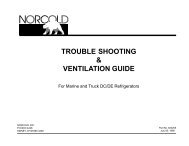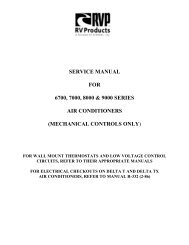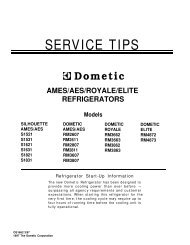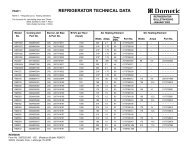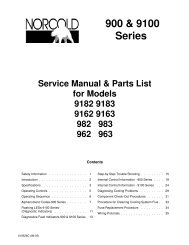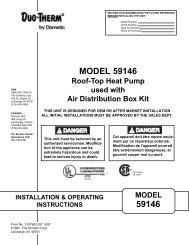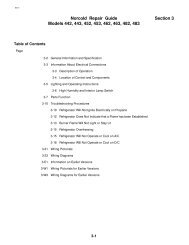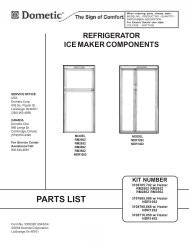10-19-00 Air Conditioner Heat Pump Service Manual - Bryant RV ...
10-19-00 Air Conditioner Heat Pump Service Manual - Bryant RV ...
10-19-00 Air Conditioner Heat Pump Service Manual - Bryant RV ...
Create successful ePaper yourself
Turn your PDF publications into a flip-book with our unique Google optimized e-Paper software.
Section A - Installation, cont’d.GrillsNote: The Return air grill must have the same square surfaceas the return air duct.1. For each air conditioning system, there must be a returngrill to bring cabin air back into the unit. Theremust also be at least four discharge grills per unit.2. Return grills must be mounted in front of the evaporator.If this is not possible, make sure there is nothingblocking the air flow from the grill to the evaporator.3. The unit must have a return filter between the grill andthe unit. This filter must be accessible for periodic cleaning.Outlet <strong>Air</strong>The air diffusion system, supplied by the installer, must besized to maintain a static pressure at the blower outlet between.4 and 1.2 inches water column.All air handling ducts must be properly insulated to preventcondensation forming on their surface during operation. Avapor barrier must also be supplied on the outer surface ofthe insulation to prevent moisture from traveling throughthe insulation and condensing on the cold ductwork. Seesection A6a - Rooftop Units.A7. Thermostat LocationThe thermostat location is very important for balancedtemperature control in any <strong>RV</strong>.Today’s interior design has become both cosmetically moreappealing and more efficient in its use of storage space.These improvements have generated complex interiorspace requirements which, in turn, have caused many <strong>RV</strong>’sto become a maze for heating and air conditioning circulation.The heating system is usually mounted close to floor leveland consists of one or more furnaces. The air conditioner(s)is mounted on the roof with a different air distribution system.It is very important to locate the thermostat and remotesensors in areas that have good air movement. Thismay be difficult because what works well for heating maynot work well for air conditioning.The thermostat or remote sensors must be placed in a locationwith good air movement. Placing a thermostat orsensor under a cabinet or in a corner will result in a largefluctuation in the temperature. See FIG. A25.FIG. A25The proper location for the thermostat or remote sensor is54" from the floor and on an inside wall. It should be locatedwhere it cannot be affected by heat from the sun,lamps, oven, etc., or other sources of draft. Locations closeto entry doors and windows should be avoided. The dischargefrom registers blowing directly on the thermostat orremote sensor can cause the system to short-cycle andshould be avoided. See FIG. A26.FIG. A26Examples of Bad Thermostat Locations1, 3, 4 Near <strong>Heat</strong> Sources2 Near Drafts or <strong>Heat</strong> source5, 6 Near Drafts7 On an Outside Wall12



